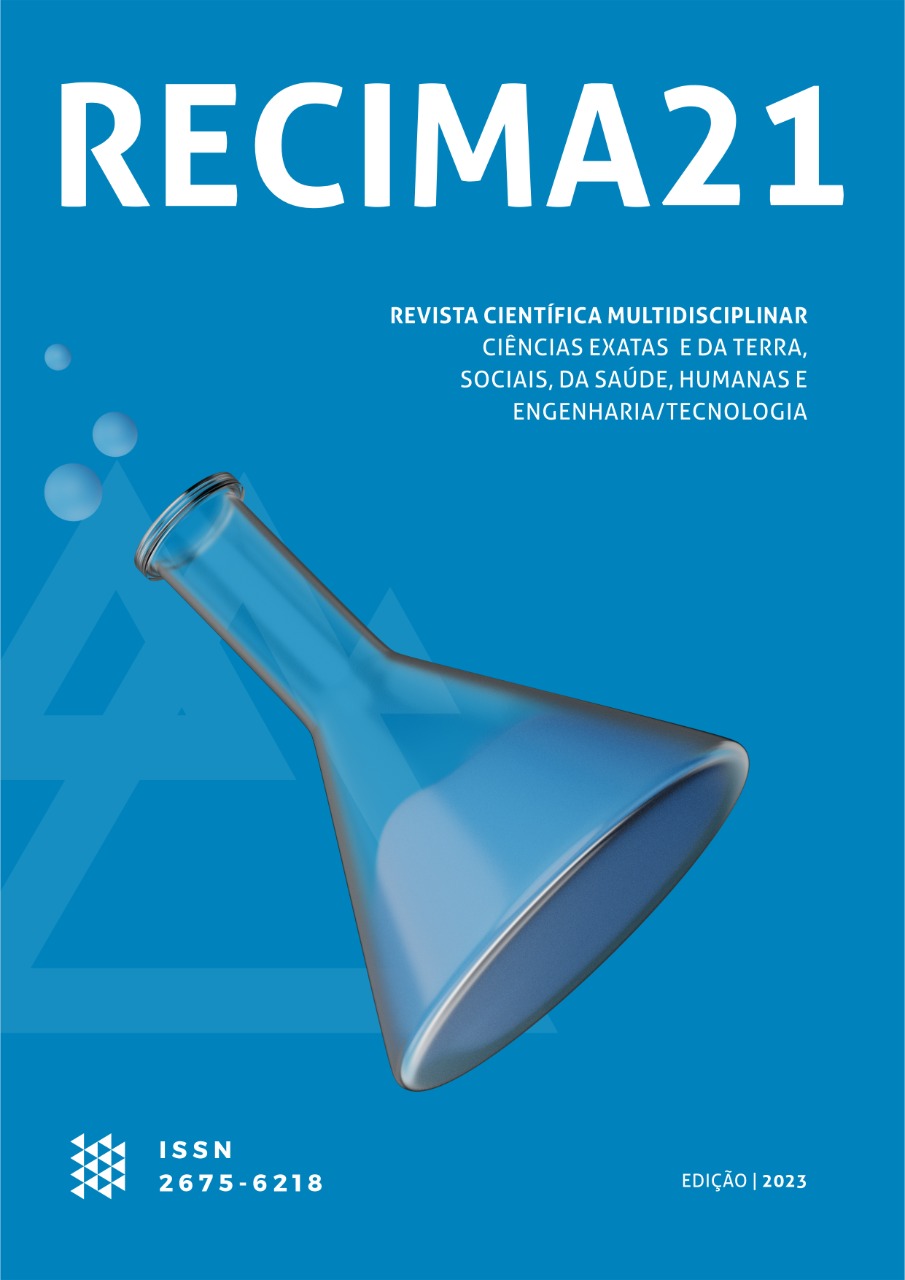CARACTERIZAÇÃO ANATÔMICA E HISTOQUÍMICA DO NECTÁRIO FLORAL DE VANILLA PALMARUM
DOI:
https://doi.org/10.47820/recima21.v4i10.4232Palavras-chave:
Nectário, Vanilla, InteraçãoResumo
A polinização de diversas flores é possível graças às recompensas existentes nas flores, as quais permitem uma interação trófica mutualística entre plantas e animais. No entanto, algumas flores são conhecidas pelo engodo alimentar, onde só existe a sinalização do recurso e não a disponibilidade dele, por muito tempo se acreditou que as flores do gênero Vanilla compartilhavam dessa característica, no entanto, essa associação está sendo cada vez mais desmascarada através de pesquisas sobre espécies do gênero, e mais estudos são necessários para entender melhor a morfologia, anatomia e histoquímica referente aos tecidos nectaríferos e suas secreções.
Downloads
Referências
ANDERSEN, Alan N.; BRAITHWAITE, Richard W. Plant-animal interactions. In: Landscape and vegetation ecology of the Kakadu Region, northern Australia. Dordrecht: Springer Netherlands, 1996. p. 137-154.
Baker, H. G., and Baker, I. (1973). Amino-acids in nectar and their evolutionary significance. Nature 241:543.
BARÔNIO, Gudryan Jackson et al. Entre flores e visitantes: estratégias de disponibilização e coleta de recursos florais. Oecologia Australis, v. 22, n. 4, 2018.
BEUTLER, Ruth. Nectar. Bee World, v. 34, n. 6, p. 106-116, 1953.
Bory, S., Grisoni, M., Duval, MF. et al. Biodiversity and preservation of vanilla: present state of knowledge. Genet Resour Crop Evol 55, 551–571 (2008).
BOUCHER, Douglas H.; JAMES, Sam; KEELER, Kathleen H. The ecology of mutualism. Annual Review of Ecology and Systematics, v. 13, n. 1, p. 315-347, 1982.
DA GLÓRIA, Beatriz Appezzato; GUERREIRO, CSM. Anatomia vegetal. Universidade de São Paulo. ESALQ, 1992.
DAFNI, Amots et al. Pollination ecology: a practical approach. Oxford University Press, 1992.
FAHN, Abraham. Secretory tissues in vascular plants. New phytologist, v. 108, n. 3, p. 229-257, 1988.
GAHN PB 1984. Plant histochemistry and cytochemistry: an introduction. Academic Press, London.
GALETTO, Leonardo; BERNARDELLO, Gabriel. Floral nectaries, nectar production dynamics and chemical composition in six Ipomoea species (Convolvulaceae) in relation to pollinators. Annals of botany, v. 94, n. 2, p. 269-280, 2004.
GOLDAR, Xosé López; NÚÑEZ, Francisco Alejandro López. La evolución en la polinización: orígenes e hipótesis actuales. Dep. Legal: C, p. 26-2014, 2014.
Jersáková, J.; Johnson, S.D. & Kindlmann, P. 2006. Mechanisms and evolution of deceptive pollination in orchids. Biological Reviews, 81, 219-235.
JOHANSEN, Donald Alexander. Plant microtechnique. McGraw-Hill Book Company, Inc: London; 530p, 1940.
KIRK JUNIOR, P.W. Neutral red as a lipid fluorochrome. Stain Technology, v. 45, n. 1,
Knox, R. B., Kenrick, J., Bernhardt, P., Marginson, R., Beresford, G., Baker, I., & Baker, H. G. (1985). Extrafloral nectaries as adaptations for bird pollination in Acacia terminalis. American Journal of Botany, 72(8), 1185-1196.
KOPTUR, Suzanne. Extrafloral nectary-mediated interactions between insects and plants. In: Insect-Plant Interactions (1992). CRC press, 2017. p. 89-138.
MARTINS, Aline Cristina. Abordagens históricas no estudo das interações planta-polinizador. OecologiaAustralis, v. 7, n. 7 (2), p. 229-242, 2013.
MCMANUS, J. F. A. Histological and histochemical uses of periodic acid. Stain technology, v. 23, n. 3, p. 99-108, 1948.
MESQUITA-NETO, José Neiva et al. Nectar secretion of floral buds of Tococa guianensis mediates interactions with generalist ants that reduce florivory. Frontiers in Plant Science, v. 11, p. 627, 2020.
NICOLSON, Susan W. et al. (Ed.). Nectaries and nectar. Dordrecht: Springer, 2007.p. 1-4, 1970.
OLLERTON, Jeff; WINFREE, Rachael; TARRANT, Sam. How many flowering plants are pollinated by animals?. Oikos, v. 120, n. 3, p. 321-326, 2011.
PACINI, ENMVJ; NEPI, M.; VESPRINI, J. L. Nectar biodiversity: a short review. Plant Systematics and Evolution, v. 238, n. 1-4, p. 7-21, 2003.
PANSARIN, Emerson R. Vanilla flowers: much more than food-deception. Botanical Journal of the Linnean Society, v. 198, n. 1, p. 57-73, 2022.
PANSARIN, Emerson Ricardo; AMARAL, Maria do Carmo Estanislau do. Reproductive biology and pollination mechanisms of Epidendrum secundum (Orchidaceae). Floral variation: a consequence of natural hybridization? Plant Biology, v. 10, n. 2, p. 211-219, 2008.
PANSARIN, L. M. et al. So small and so rich: diversity of floral resources in miniature Oncidiinae (Orchidaceae) and their relation to pollinators. Plant Biology, v. 23, n. 2, p. 259-266, 2021.
PEARSE A. G. E., 1985 - Histochemistry: theoretical and applied. Vol.2, 4th ed., Churchill Livingstone, Edinburgh, 1055 pp.
PEARSE, AG Everson. Carbohydrates and mucosubstances. Histochemistry, theoretical and applied, 1985.
PERCIVAL, Mary S. Types of nectar in angiosperms. New Phytologist, p. 235-281, 1961.
REAL, Leslie (Ed.). Pollination biology. Elsevier, 2012.
RECH, André Rodrigo et al. (Ed.). Biologia da polinização. Rio de Janeiro: Projeto Cultural, 2014.
SILVA¹, Ary G.; LUTZ, Leonardo V. Sinalização ou atração floral? Uma abordagem química para a polinização. 2004.
WASER, Nickolas M. The adaptive nature of floral traits: ideas and evidence. Pollination biology, v. 1, p. 241-285, 1983.
ZIMMERMANN, J. Uber die extrafloralen Nektarien der Angiosperm. Bot. Centralb., v. 49, p. 99-196, 1932.
Downloads
Publicado
Licença
Copyright (c) 2023 RECIMA21 - Revista Científica Multidisciplinar - ISSN 2675-6218

Este trabalho está licenciado sob uma licença Creative Commons Attribution 4.0 International License.
Os direitos autorais dos artigos/resenhas/TCCs publicados pertecem à revista RECIMA21, e seguem o padrão Creative Commons (CC BY 4.0), permitindo a cópia ou reprodução, desde que cite a fonte e respeite os direitos dos autores e contenham menção aos mesmos nos créditos. Toda e qualquer obra publicada na revista, seu conteúdo é de responsabilidade dos autores, cabendo a RECIMA21 apenas ser o veículo de divulgação, seguindo os padrões nacionais e internacionais de publicação.













